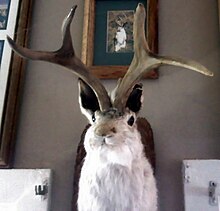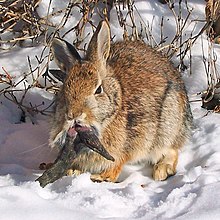Jackalope: Difference between revisions
m I have fixed some incorrect details about the mythical beast. |
no you haven't |
||
| Line 1: | Line 1: | ||
{{About|the mythical animal|}} |
{{About|the mythical animal|}} |
||
[[File:Jackalope 101.jpg|thumb|A mock-up of a stuffed Jackalope in a restaurant near Death Valley]] |
[[File:Jackalope 101.jpg|thumb|A mock-up of a stuffed Jackalope in a restaurant near Death Valley]] |
||
The '''jackalope''' is a |
The '''jackalope''' is a [[mythical animal]] of [[North America]]n folklore (a so-called "[[fearsome critter]]") described as a [[Hare|jackrabbit]] with [[Pronghorn|antelope]] horns or [[deer]] antlers and sometimes a [[pheasant]]'s tail (and often hind legs). The word "jackalope" is a [[portmanteau]] of "jackrabbit" and "antelope". |
||
The story of the jackalope was popularised in Wyoming in the 1930s after a local hunter used taxidermy skills to graft deer antlers onto a jackrabbit carcass, selling the creature to a local hotel. It is possible that the tales of jackalopes were inspired by sightings of rabbits infected with the ''[[Shope papilloma virus]]'', which causes the growth of horn- and antler-like [[tumor]]s in various places on the rabbit's head and body.<ref name="jacksforreal">{{cite web| url= http://sites.lafayette.edu/hollidac/links-for-fun/jackalopes/real-jackalopes/ | title= Real "jackalopes": rabbits infected with the Shopes papillomavirus| first= Chuck | last= Holliday| publisher= Lafayette College|accessdate=2014-06-16}}</ref><ref>Eberhart, George M. "Mysterious Creatures: Creating A Cryptozoological Encyclopedia." 2005. Journal of Scientific Exploration. Vol. 19, No. 1, pp. 103-113</ref> The concept of an animal hybrid occurs in many cultures, such as the [[griffin]] and the [[chimera (mythology)|chimera]], and [[Lepus cornutus|horned hares]] were described in medieval and early Renaissance texts. |
The story of the jackalope was popularised in Wyoming in the 1930s after a local hunter used taxidermy skills to graft deer antlers onto a jackrabbit carcass, selling the creature to a local hotel. It is possible that the tales of jackalopes were inspired by sightings of rabbits infected with the ''[[Shope papilloma virus]]'', which causes the growth of horn- and antler-like [[tumor]]s in various places on the rabbit's head and body.<ref name="jacksforreal">{{cite web| url= http://sites.lafayette.edu/hollidac/links-for-fun/jackalopes/real-jackalopes/ | title= Real "jackalopes": rabbits infected with the Shopes papillomavirus| first= Chuck | last= Holliday| publisher= Lafayette College|accessdate=2014-06-16}}</ref><ref>Eberhart, George M. "Mysterious Creatures: Creating A Cryptozoological Encyclopedia." 2005. Journal of Scientific Exploration. Vol. 19, No. 1, pp. 103-113</ref> The concept of an animal hybrid occurs in many cultures, such as the [[griffin]] and the [[chimera (mythology)|chimera]], and [[Lepus cornutus|horned hares]] were described in medieval and early Renaissance texts. |
||
Revision as of 00:33, 4 September 2014

The jackalope is a mythical animal of North American folklore (a so-called "fearsome critter") described as a jackrabbit with antelope horns or deer antlers and sometimes a pheasant's tail (and often hind legs). The word "jackalope" is a portmanteau of "jackrabbit" and "antelope".
The story of the jackalope was popularised in Wyoming in the 1930s after a local hunter used taxidermy skills to graft deer antlers onto a jackrabbit carcass, selling the creature to a local hotel. It is possible that the tales of jackalopes were inspired by sightings of rabbits infected with the Shope papilloma virus, which causes the growth of horn- and antler-like tumors in various places on the rabbit's head and body.[1][2] The concept of an animal hybrid occurs in many cultures, such as the griffin and the chimera, and horned hares were described in medieval and early Renaissance texts.
Myth


The jackalope has led to many outlandish (and largely tongue-in-cheek) claims as to the creature's habits. It is given the pseudo-taxonomic descriptor Lepus temperamentalus.[3] It is said to be a hybrid of the pygmy-deer and a species of "killer rabbit". Reportedly, jackalopes are extremely shy unless approached. Legend also has it that female jackalopes can be milked - as they sleep belly up - and that the milk can be used for a variety of medicinal purposes.[4] One of the few ways a Jackalope can be caught is by leaving out a bottle of whiskey, as it is the jackalope's sustenance of choice.[5] It has also been said that the jackalope can convincingly imitate any sound, including the human voice. It uses this ability to elude pursuers, chiefly by using phrases such as "There he goes! That way!" During days of the Old West, when cowboys gathered by the campfires singing at night, jackalopes could often be heard mimicking their voices.[6] Legend has it that they are dangerous if approached. It has also been said that jackalopes will only breed during winter electrical storms, explaining their rarity.
The New York Times attributes the story's origin to a 1932 hunting outing involving Douglas Herrick (1920–2003) of Douglas, Wyoming.[7] Herrick and his brother had studied taxidermy by mail order as teenagers, and when the brothers returned from a hunting trip for jackrabbits, Herrick tossed a carcass into the taxidermy store, where it came to rest beside a pair of deer antlers. The accidental combination of animal forms sparked Herrick's idea for a jackalope.[8] The first jackalope the brothers put together was sold for $10 to Roy Ball, who displayed it in Douglas' La Bonte Hotel. The mounted head was stolen in 1977.[9] The jackalope became a popular local story, and Douglas Chamber of Commerce has issued thousands of Jackalope Hunting Licenses to tourists. The tags are good for hunting only during official Jackalope season, which occurs for only one day: June 31 (a nonexistent date as June has 30 days), from midnight to 2 AM. The hunter may not have an IQ greater than 72.[7] In Herrick's home town of Douglas there is a statue of a jackalope, and the town celebrates Jackalope Day every year.[10]
Mythological references to a horned rabbit creature can be found in the Huichol legends. The Huichol oral tradition has passed down tales of the sharing of horns between the deer and the horned rabbit.[citation needed] This folklore may originate in sightings of rabbits affected by the papilloma viral infection, which was reported in the Western United States and Mexico from the 1880s - 1930's.[11] The rabbit and deer have also been paired up as far back as the Mesoamerican period of the Aztecs[12] as twins, brothers, even the sun and moon.[13]
Stories about similar hybrid rabbits exist in alpine and Scandinavian regions of Europe. Such creatures include the Wolpertinger (Bayern, Germany), the Blutschink (Tirol, Austria), the Dahu (Switzerland, France), the Dilldapp (some specific regions), the Elwetritsch (Pfalz, Germany), the Hanghuhn (Thüringen, Germany), the Raurakl (Schwarzau im Gebirge, Austria), the Rasselbock (Thüringen and Sachsen, Germany) and the Skvader (Medelpad in northern Sweden).
Official recognition
In 2005, the state legislature of Wyoming considered a bill to make the jackalope the state's official mythological creature.[14] It passed the house by a 45-12 margin, but the session ended before the senate could take up the bill, and so it died. In 2013, following the death of the bill's sponsor, Dave Edwards, the state legislature reintroduced the bill.[15] It again passed the House but died in the rules committee of the senate.[16]
Uses

Since Herrick and his brother began selling manipulated taxidermy heads in the 1930s, such trophies can be found in many bars and homes across the United States. Herrick's postcards of the jackalope also increased the myth's popularity.[10] Ronald Reagan was given a rabbit head with antlers by South Dakotan senator James Abdnor in 1986.[17]
Jackalope have also appeared in video games. In Red Dead Redemption, the player is able to hunt and skin jackalope as an in-game challenge. In Redneck Rampage, jackalope are an aggressive enemy encountered early on in the game.[citation needed] Jackalopes play part in an in game event and is also one of the rarest purchasable mini pet in Guild Wars 2.
Jakalope is a Canadian alternative pop/rock group formed in 2003 by industrial musician and producer Dave "Rave" Ogilvie.[18] The band Miike Snow uses the Jackalope as their logo.[19]
"The Jackalope" or "Jack Ching Bada Bing" was a recurring character in a series of sketches on the American TV show America's Funniest People (1990-1994), where he would play pranks on his nemesis, in a similar style to a Bugs Bunny Cartoon.[20] In the animated television series Gravity Falls, jackalopes occasionally appear in the opening sequence and photos.
Children’s author Bruce Larkin incorporates jackalopes into many of his books and poetry, and describes himself as "the world’s foremost jackalopoligist".[21][non-primary source needed]
Beginning in 1997, the Central Hockey League included a team called the Odessa Jackalopes; a team of that name has more recently been a member of the South Division of the North American Hockey League
In 2004 Pixar featured a jackalope in their short animation Boundin'. He gave helpful advice to a lamb who was feeling down after being shorn.[22]
The Hop Factory craft beer cafe in Newcastle, Australia uses a leaping Jackalope as its logo.[23]
See also
References
- ^ Holliday, Chuck. "Real "jackalopes": rabbits infected with the Shopes papillomavirus". Lafayette College. Retrieved 2014-06-16.
- ^ Eberhart, George M. "Mysterious Creatures: Creating A Cryptozoological Encyclopedia." 2005. Journal of Scientific Exploration. Vol. 19, No. 1, pp. 103-113
- ^ "The Jackalope Conspiracy". Sudftw.com. Retrieved 2011-11-17.
- ^ "Jackalope, The Legend « Kristal Lee". Kristalleeromances.com. 2011-04-11. Retrieved 2011-11-17.
- ^ "Ghost Knight" Karen Coats From: Bulletin of the Center for Children's Books Volume 65, Number 10, June 2012 pp. 509-510
- ^ "The Jackalopes of Wyoming - Myth or Reality?". Legendsofamerica.com. 2006-11-16. Retrieved 2011-11-17.
- ^ a b "Douglas Herrick, 82, Dies (Section 1, Page 23)". The New York Times. 2003-01-19. Retrieved 2011-11-17.
- ^ "The Origin of the Jackalope". Douglas [Wyoming] Chamber of Commerce. 2008. Archived from the original on 2008-05-13. Retrieved 2014-06-16.
- ^ "Douglas Herrick, 82; on a Whim He Created 'Jackalope'". Los Angeles Times. 2008-11-06. Retrieved 2011-11-17.
- ^ a b "The Jackalope". Museumofhoaxes.com. 2003-01-06. Retrieved 2011-11-17.
- ^ Barbour, Erwin H. 1901 "A Peculiar Disease of Birds' Feet Observed in Central Nebraska." Proceedings of the Nebraska Ornithological Union 2:61-63
- ^ Codex Borgia 1976:33
- ^ Furst, J.L. "Horned Rabbit: Natural History and Myth in West Mexico." Journal of Latin American Lore 15:1 (1989), 137-149
- ^ "Wyoming Legislature Journal Digest". Legisweb.state.wy.us. Retrieved 2014-07-12.
- ^ "Wyoming lawmakers consider declaring jackalope state's official mythical creature". Trib.com. 2013-01-12. Retrieved 2014-03-14.
- ^ "House Bill 149". Trib.com. 2013-02-26. Retrieved 2014-03-14.
- ^ http://news.google.com/newspapers?id=2VIcAAAAIBAJ&sjid=7VEEAAAAIBAJ&pg=7017,7684015&dq=reagan+jackalope&hl=en
- ^ "Jakalope". Jakalope.ca. Retrieved 2014-04-14.
- ^ Madison, Lucy. "Putting the I's in Miike Snow". Interview. Retrieved 2012-11-25.
- ^ Video on YouTube
- ^ Larkin, Bruce. "Jackalope Research Institute." Jackalope Research Institute. Wilbooks, Inc., n.d. Web. <http://jackaloperesearchinstitute.org/>.
- ^ "Pixar". Pixar. Retrieved 2014-04-25.
- ^ "New Craft Beer Digs in Newcastle". Beerandbrewer.com. Retrieved 2014-03-14.
